Text
Quill and Blade
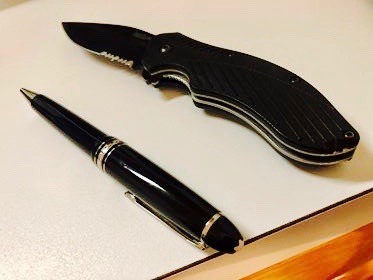
The pen is mightier than the sword, but I still carry a knife. That is, a pen and a knife.
A friend of mine once said, “if you’re going to carry a knife, you might as well carry a gun.” I’m not so sure this line of thinking holds up completely unless you live in a place that requires this. I mean, you sure don’t want to bring a knife to a gun fight, but if you find yourself in need of some sort of protection, it’s better to have a knife than nothing at all. I think that this is true even if you’re the sort of person who would most likely wind up having your own knife used against you. Who knows... Maybe that will be me someday (I doubt it), but I digress.
Moving on, I don’t plan to engage in any fights nor do I think that I will need protection that would be dire enough to require the use of any sort of weapon for self-defense. My life is, fortunately, a peaceful one. I carry a knife to open beers and boxes—not people. And I carry a pen because it provides a feeling of being prepared and tends to shock most servers when you’ve signed something with your Montblanc before they can hand you their disposable ink container. One shouldn’t miss the opportunity to experience this level of refined, personal entertainment.
In conclusion, carry a pen and a knife. It’s civilized and sexy and it lets people know that you’re both intelligent and dangerous—sometimes.
0 notes
Text
Writing as Medicine

Writing has become my number one source of therapy. Writing is healing. It is calming. It is grounding. When I write, I bring my mind into this present moment. They say depression comes from extreme rumination on the past and anxiety is excessive worrying about the future. As a person who has lived with clinical depression and anxiety since childhood, I am in a unique position to speak to the healing powers of writing as I have experienced them.
For many years, so much of my time was spent thinking about the past and the future with very little attention to the present. It still happens. I still have panic attacks and I still experience days where I can barely get out of bed, but by focusing on this present moment, I have improved my condition substantially. As long as I wake up to writing and I really focus on where I am, what I am doing, and what I have to say right now, I will feel a lot better than I would if I did not engage in this daily practice.
The most important part of employing writing as therapy, for me, has been including a regular practice of journaling my dreams. By journaling my dreams I gain insight into areas of my life that were unconscious. Spending time thinking about the dreams and arriving at what they mean to me is a way that I have created a positive relationship to the past and the future. When ruminating on my dreams, I rarely feel depressed and find myself in an ongoing state of curiosity and sometimes excitement. This also almost equally counteracts anxiety in many instances. As long as I am completely focused on journaling my dreams, my mind can’t fully develop a negative story that might instigate my fight-or-flight responses.
Additionally, when I am feeling a panic attack coming on, the first thing that I know I can do to slow things down is to open my iPhone and begin typing everything that is happening right then and there. This has been great for when having been suddenly overcome by irrational fear in public situations.
From this experience, I feel that I can safely recommend writing as a daily practice to everyone. It can be a large part of one’s safety net. The writing doesn’t even have to be any good at first. One only improves their writing by writing all of the time. So each person taking this advice will do well to start right now, right where they are, and begin to enjoy the journey of self-expression by finding ways to write better sentences. Better sentences equal clearer meaning. Once one finds that they are in the flow and that they are finding their voice, then looking deeper into the mechanics of writing will improve the experience for the writer and the reader.
While there is always more to learn, and I know my own writing is far from perfect, it feels great to finally arrive at a place where one’s writing is expressing what feels to be more precise meaning. And the only way this can be achieved is through daily practice, much like a form of yoga. My hope is that someone will read this, open up their favorite writing medium, and then get busy! The promise that I can make is this: writing will eventually help almost anyone to feel better; or at the very least, feel connected to the present moment.
Image source: https://www.pexels.com/photo/hands-coffee-cup-apple-5199/
0 notes
Text
An Entitled Author

Ever feel betrayed by the promise of a book? “Entitlement Abolition: How to Lead your Family from Me to We,” by Douglas R. Andrew, offers some decent insights, but at the expense of the integrity of the author.
In the introduction, Douglas claims “this book does not have a religious or political agenda” (p. x). Then within the next few pages, the reader is betrayed by the author. On page ten, Douglas begins to describe his “Christian” values and uses Bible verses to support his ideas, which normally would be fine since we’re all welcome to decide if we like the way the author is making their point(s). While I do not have a problem with someone explaining how their religious values work for them, nor am I against the use of Bible verses as a source of inspiration, I do not respect a text that makes a promise and then breaks it unless it’s a great work of fiction.
Assuming positive intent, perhaps the author doesn’t understand how describing his religious worldview is, in fact, promoting a “religious agenda.” He wants to bring people to his side. He wants to convince the reader that his ideas and practices are worth integrating into the reader’s life. And yet, he does that by using religion-based examples, which generally don’t work for people from other religious backgrounds, nor the non-religious, and makes taking this book seriously very difficult for non-Christians. A Muslim or Buddhist or atheist, for example, will have to wade through all of the author’s Christian messaging to arrive at any valuable takeaways. Douglas promised he wouldn’t make us go through that and then he made us go through that.
Not but a few more pages in, the second promise is betrayed: the promise not to be political. Douglas claims “even the poor who become accustomed to receiving handouts lose that humble dedication to growth, learning, and cooperation that brought about that abundance” (p. 15), referring to abundance created by people who generate income by working (possibly forgetting that most of the wealth that exists has been handed down through generations and is permanently inaccessible to the majority of people). Let’s unpack this.
Douglas is suggesting that “poor people” have the resources to “grow, learn, and cooperate” in a capitalistic nation where the vast majority of the wealth was already possessed by other people at the time and place of their birth. How many people can you really expect to successfully tap into other people’s wealth and make constructive use of it? It can’t be everyone. The fact is, most poor people—or rather disenfranchised people—will either find a way to sustain themselves or they will die. By providing some level of free resources to the poor, we give them a chance to decide how that’s going to go. To suggest that we—those of us who have resources—shouldn’t help them is some coldhearted, law-of-the-jungle thinking. People above the poverty line and higher will never have to worry about this. That is a monumental privilege. This means that the poor are not experiencing the same kind of entitlement as anyone else who might be experiencing entitlement.
So why is the claim that the poor are just as entitled as the lazy rich a betrayal to the reader? The notion that “the poor”—the disenfranchised and unlucky majority—take what they can as a “handout,” is a well-known, typical right-wing conservative agenda: abandon the poor, praise the rich, and work like hell to pay the bills and feel individually and religiously superior and righteous about it. Then, bark at others for not doing the same. “Why should my tax dollars go to pay for some lazy bum?!” Bear in mind, I’m not addressing some of the valuable notes that certain entitled and privileged people should take from the book, I am specifically addressing what is clearly a political attitude about how we ought to help people who have next to nothing.
Where Douglas fails is, he immediately expects everyone to assume that all entitlement is bad and he predicates this upon a common political agenda. He suggests that we’re not helping the poor by giving them money, so don’t give them anything. The author’s religious book, the Bible, speaks expressly against this line of thinking (see below). That aside, like I said earlier about his religious agenda, it would be fair of him to express these views if he had simply been honest about their origin in the first place, but he wasn’t. And so, to drive the key point home, he said he was not going to bring religion or politics into his book, but he did. This directly undermines the trust the reader can have with this author.
It’s great that Douglas wants to teach people how to have a positive can-do attitude and to assume that the best way to live life is to be productive and serve a god (even though believing in literal gods is a primitive structure of consciousness) while implementing known-good processes, but he predicates his claims on an agenda that he promised he wouldn’t at the beginning of the book!
Even if some of his information is helpful to people, that still doesn’t make him any less of a liar, having betrayed the reader right up front in those two ways. And that still doesn’t mean that he’s the authority on how to live life as a human in the world. At best, this is a relatively well-written support mechanism for people who already believe what he’s saying is true. In essence, he is, in fact, enabling people and not empowering them with this text, even if some of this text can help people to empower themselves. Slightly paradoxical, it seems, since one of his core values is to move from enabling to empowering. Digging deeper into why this author might’ve been unconscious to his own betrayal of the reader, again assuming positive intent, let’s look at some basic facts about the man himself and see how this book might actually be a form of finger-pointing where the truth is that the author is not only himself entitled but also (trigger word) privileged.
If you’re going to make the case for a worldview and a way of life, it needs to come from a place of integrity, objectivity and, most important of all, honesty. All Douglas had to say (to come clean) was, “I base my beliefs and practices on Christian values and a [seemingly] right-wing conservative agenda.” Or he could’ve left that disclaimer sentence out entirely!
However, then it would’ve been harder for him to sell books, maybe. I wonder how many people bought the book, got a few pages in, and then threw it away... In any case, the deeper reality about the origin of this kind of writing from this author is that Douglas is not only privileged, he is also hypocritically entitled by thinking that he can lie to his readers and take their money and that somehow he deserves to make a living this way. How more self-righteous could you be?
Douglas should take every penny he has earned from this book and give it to the so-called “poor,” (people who are actually disenfranchised, or rather, deprived of access) because that would be the “Christian” thing to do. Look at what the Bible has to say (since I did not promise not to use his own weapon against him) about giving money. Here are some Bible verses that appear to challenge the values presented in his book:
1 Timothy 5:8 ESV / 161 “But if anyone does not provide for his relatives, and especially for members of his household, he has denied the faith and is worse than an unbeliever.”
Proverbs 19:17 ESV / 195 “Whoever is generous to the poor lends to the Lord, and he will repay him for his deed.”
Matthew 5:42 ESV / 102 “Give to the one who begs from you, and do not refuse the one who would borrow from you.”
Deuteronomy 16:17 ESV / 74 “Every man shall give as he is able, according to the blessing of the Lord your God that he has given you.”
Proverbs 21:26 ESV / 41 “All day long he craves and craves, but the righteous gives and does not hold back.”
Read more here, if you’re interested in the author’s text of authority: https://www.openbible.info/topics/giving_money
Again, Douglas makes some good points throughout the book about what any person might want to consider, but as an instruction manual for how to be a person, this work cannot begin by pulling the rug out from under the reader if it’s to have any lasting value. There was a promise to deliver this material in a secular and unbiased fashion and that clearly did not happen.
Furthermore, according to the Bible, it’s not up to us to decide what other people do with what they are given. And giving is good! You give what you can and then the outcome is not up to you. Also, if you are on the receiving end, you are not obligated to do anything in particular with what you are given. What will be will be.
Now, if we’re NOT assuming positive intent, I can move directly to what appears to be the case from the perspective of a non-Christian. This book was created to support the values and ontology of an audience of people who are already set up to agree with every word. This text might even be used to impose values and practices upon others that could be harmful to their mental and/or physical reality. For example, many poor and homeless people have disabilities, mental illness, or have simply been left behind and do not have the skills necessary to support themselves, much less a family.
"Entitlement Abolition” is not a work that invites critical thinking. The hubris of the narrative is one that speaks as if it is demanding to parent the world. Douglas R. Andrew is a “wolf in sheep’s clothing,” in some ways, at times pushing a right-wing conservative Christian agenda about how to live a life that benefits the individual and their family, but judges and alienates others.
While there might be some valuable ideas in this book for introspection and self-improvement (and even family and community improvement), no one needs to read this specific book to learn how to live correctly or develop objectively great leadership—much less how to live well—because the author cannot be trusted to show his teeth before devouring the reader’s trust with his positive intentions.
Image source: https://www.pexels.com/photo/portrait-of-young-man-326559/
0 notes
Text
What is a “dress watch,” really?
Here is my Calatrava. The best of them all (my Uncle Bert’s Calatrava being the only exception, not listed here): the 5153G-001 from Patek Philippe. It has not at all been dusted off for posterity because it is a living watch, but it’s still—in my humble opinion (imho)—the best dress watch in the world. The image does not specifically show a dress occasion, but the truth is that it was worn to an occasion that deserved it: my mother’s retirement party, but I digress. On to the actual topic.
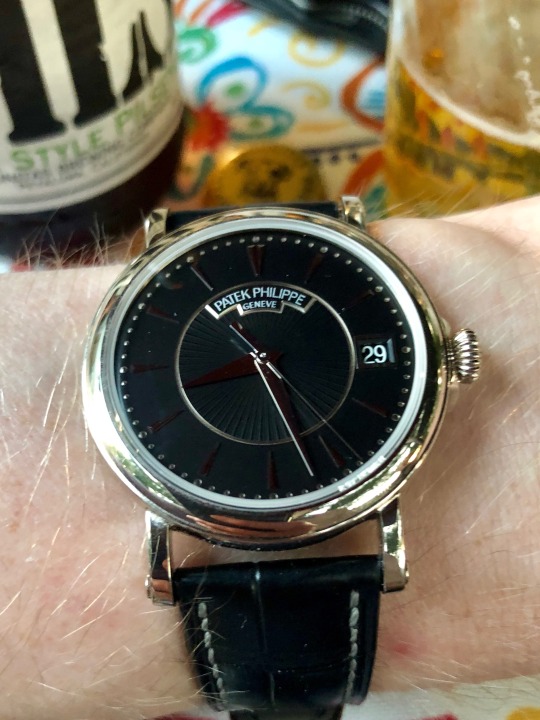
We really need to dig deeper into what is meant by the colloquial implication of “dress watch.” Some think that anything “expensive” is a dress watch. That is nonsense. There are watches that intuitively and objectively fit certain occasions better than others. Perhaps it’s time we created finer guidelines around what one would wear to say about 10 to 20 different types of “dress occasions.” I won’t be doing that, but I will offer something worth reading in the spirit of horological community thinking.
Since I am the narrator here, naturally I’ll go first. My BLNR (Rolex 116710 GMT-Master II) is not a dress watch. It is not appropriate for a funeral, for example. My Calatrava is a dress watch, and I would not wear it to a barbecue. My El Primero (Zenith Chronomaster 1969) is a sports watch that I have designated for driving and sleeping. So, why/how have I made these choices/designations? Time to keep digging. Some of these reference number nerds and design nerds can provide extra insight, but I will employ the depth psychological and philosophically practical lenses.
The first thing to do is to think about the occasion. Where do you often need to go that is considered a “dress occasion,” and where would you like to go that might be considered a “dress occasion,” or an even more important moment in your life; barring black tie or the “no-watch-allowed” white tie?
While I have certainly broken the rules in many instances, I still have a good sense of what is correct and am not positioning myself as the expert so much as I am including myself in a conversation among peers.
I wore my El Primero to the occasion where I had the chance to wear the Greubel Forsey GMT Earth, for example. I should’ve worn my Calatrava, but it was impossible for me to obtain it from the vault at the time. As it turns out, the audience at the party loved the El Primero and we used it as a way to compare a $6k watch to six-figure watches. The Calatrava would’ve been less interesting in terms of looking at the guts of a super cool timepiece that displays all of its works.
What my Calatrava and El Primero have in common is this: they have leather straps and their movements are observable. How do they differ in ways that make one a better dress watch than the other?
To start, the Calatrava is smaller. A large sports watch is garish for a high-brow or formal occasion, with few exceptions. Second, the Calatrava features the time with a very unobtrusive date aperture (some would argue that “date” is not dress at all) and as such is not as distracting or imposing as a chronograph. My only argument for the date on this particular Patek Philippe Calatrava is that it is the 5153G-001, which offers no other option, and since it is my personal favorite design of any Calatrava at any time, I had no choice but to take one with date. I would gladly take one without the date complication, but alas, that hasn’t been made. Fortunately, Patek was smart enough to make the text white with a black background in consideration of the black dial, unlike A. Lange & Söhne in many instances. However, we’re not about to breach an ALS vs. Patek debate here.
This discussion could go on for pages, so to keep it short, the most important takeaways to bring with you about what makes a dress watch, are these:
A dress watch must be discreet
This requires that it be capable of fitting under a cuff easily
Additionally it should not be distracting, it should be tasteful
In a nutshell, the idea is that you can only tell the time if necessary
Only horological aficionados should be able to notice it
When it comes to choosing design, a dress watch ought to be simple
The watch would be best if it only tells the time, and I can’t emphasize this enough: time-only watches are the best dress watches, even if most time-only watches are not dress watches
Date being a rare exception
If there are extra complications, the complications must have a conversational or otherwise urgent purpose
If you wear a sports watch, or a watch with many complications, prepare for raised eyebrows unless that specific timepiece has a unique meaning or fits in with your circle
In real life (irl), chances are no one will care which watch you are wearing, but it isn’t about them, it’s about you; and if you run into other watch folks, we’ll expect a cool story :)
There is only ever one instance where you are allowed to wear a watch of any kind to a white tie event
You are Benedict Cumberbatch
That is all, for now
I look forward to your insights and thank you for reading. Since I am an obsessive writer and editor, I may update this without alerting anyone to the changes. Often I publish first drafts just to see how they’re received. Cheers!
1 note
·
View note
Text
A Soulless Watch

What is so bothersome about the new Tudor GMT?
In a vacuum, the watch is great. 70 hours of power reserve, all of the functionality of the Rolex equivalent, and even a better ATM rating than the Rolex GMT! The bezel offers the look and feel that vintage lovers crave to this day. Even the price-point is compelling. So why tear into this watch? Why rip it apart and call it soulless? It never did anything to me!
The fact is that the tech spec advantages are not reason enough to make a case for the validity of this timepiece.
I have seen supporters and haters go at it for a while now. The conversation around the new Rolex “Pepsi” is essentially pointless because that watch is fine and deserves its place. What is vastly more worth visiting is why the Tudor GMT that looks like a Pepsi has created such polarizing opinions.
Let’s start with my conclusion and then work our way through why I feel this way by visiting opinion vs. fact. My conclusion: the Tudor GMT “Pepsi” is an artless watch that is completely lacking in any engineering or artistic integrity. The reason for this is that everything about it that one might like steals from two places that are greater than itself: the latest and greatest Rolex GMT and the vintage Rolex GMT. While some might argue “great artists steal,” in this case, there is no art in the steel.
Some might say, “Andrew, it’s essentially coming from Rolex DNA, so how is this not an extension of the original art” and you would be correct in saying that to a point, but this questioning does zero things for the argument around why this Tudor might actually be worth buying and wearing. If you say that the watch has “Rolex DNA,” then you are implying that this is basically just a cheap copy or the cheap version of the Rolex, which makes the buyer of this watch willing to settle for a cheap imitation. You might as well buy a Tag Heuer, or worse, an Invicta.
The Rolex GMT-Master was the first of its kind and to this day remains the archetype of the perfect GMT wristwatch. For any other company or subsidiary to copy it—even a sister brand—is essentially like taking a print over the original: it’s completely artless in its integrity from an origin of design perspective. Tudor could easily have created something more original, but they didn’t. Now, one might still have deep personal experiences with this copy, and one might find this “lesser” example to suit their needs just fine. If you are that person, go with god, as they say.
What I am suggesting is this: the GMT-Master—and all of its little brothers and sisters in the Rolex tribe—is and always has been a perfect watch. The thoughtfulness that goes into its architecture is second to none. The choices in movement design, materials, and overall wearability and durability are unmatched by any other manufacturer. It doesn’t matter what it costs because the composition of materials, functionality, and design is flawless.
It doesn’t matter if the Tudor has a lower price-point, a better depth rating, and better power reserve. One of the primary reasons why is, the Tudor is too thick. The case is too thick, the strap and bracelet options are too bulky, and as a result it does not accomplish what Rolex does with every GMT: superior wearability to all others. The Tudor does not conform to any wrist the way the Rolex does, and it certainly does not boast anything other than being a great way to have the GMT experience for less money. This is part of what I mean by artless.
Some might say that it’s “good enough,” but that’s not what the GMT is about. The GMT is about being the very best of what it is. Even Tag Heuer created their own copy of the GMT-Master by imitating the BLNR. This is shameless, artless watchmaking. When you place any of these imitators next to any iteration of the Rolex GMT, it is evident right away that there is something not quite right with the others.
If you are able to get your hands on $4k US, you can find a way to get your hands on $10k and buy the real thing. You might even find a better deal than that, but the point is, if you have as much experience and knowledge as many of us watch geeks and nerds do, you know there’s no excuse for buying a GMT that isn’t the exact GMT that satisfies all your hopes and dreams for owning the best GMT there is. For some it’s about owning a birth-year GMT. For me it’s about owning an R2D2 companion that exhibits the finest of Rolex’s innovations in watchmaking when it comes to materials, such as their white gold hands and indices, the two-color Cerachrom bezel, and 904L stainless steel, which I must say feels much better on the wrist than the white gold case and bracelet.
For the person who has purchased the Tudor GMT homage to the original who genuinely believes that this is the best iteration that there is, I want to hear from that person. However, I can assure you that it is a fact that when you buy a watch that costs less than the one you really wanted in the first place, to say that it’s just as good is only you fooling yourself. The watch that is “less than” is nothing other than a “shitter.” If it’s all you can afford, work harder, or at least be more creative with how you fulfill your horological dreams.
There are other reasons why the Tudor simply isn’t worth buying in low. The movement isn’t at the same level in terms of long-term value and finishing, the steel and bulk of other materials are not at the same level as previously mentioned, the overall ergonomics are definitely not even close, and if you consider the resale value—even though these are early days—how proud of this Tudor are you going to be really when everyone else’s GMT continues to appreciate and your Disneyland souvenir of a watch wont even move on eBay anywhere close to what you paid down the road? Even if I’m wrong about resale, the worst question you’re going to get is, “is that a Rolex?” And you get to sheepishly say, “no, it’s actually a Tudor.” And the color will run out of both of your faces.
Do yourself a favor and search inward to get clear about why you might choose the Tudor GMT over any other Rolex GMT. If it’s really just about money, I can understand that, even though I don’t actually care. However, if you have a serious argument regarding the complete package of one watch vs. the other, let’s have it! My mission in horology is always to help a person be completely honest with themselves about which watches are the perfect fit for them during this limited lifetime. You are on your deathbed. Do you see yourself with the Tudor or the Rolex? I’m fairly certain that most of us will go for the real thing.
2 notes
·
View notes
Text
An Horological Treatment of “Religion”
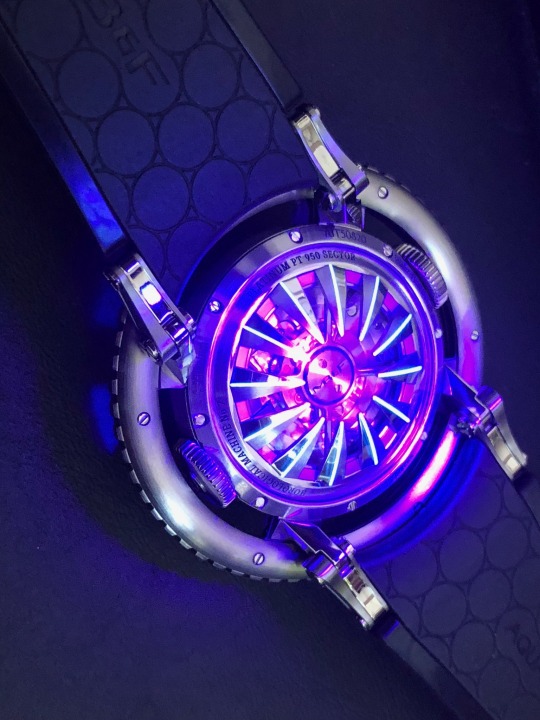
Religion isn’t actually about belief or faith. It is a structure of consciousness. Technically the 2nd or 3rd out of 4 or 5. For more on that, read “The Ever-present Origin.” And yes, “the one thing I know is that I know nothing,” however the appendix to that statement is that what I know comes from experience and if you haven’t read the book—and if you haven’t been through years of depth psychology training—then you don’t know what I know.
We can save the argument around how “belief” and “faith” are intellectually irresponsible for later. Your powerfully spiritual experiences are a matter of synchronicity, but I digress.
I know that the stories religions create are not literally true (part of the need for hermeneutics), even if they can be experienced imaginally, which makes them liminally true (not corporeally present, hence liminal), but no one knows what powers-fuels-catalyzes our universe, outside of what we’ve discovered in physics (energy can neither be created nor destroyed, etc.). The optimist says, “we’re on to something,” which inspires flawed hopefulness. The nihilist realizes that none of this matters (or is intrinsically meaningful) in any literal reality, which brings flawed, logical and illogical depression and anxiety. Instead of the healthy “tension between opposites” we have a “flaccidity between opposites;” (most of the time) or rather, no more motive to do anything in any direction.
So, to prevent mass-suicide, we’re left with a mission: to create order out of chaos (the telos of the psyche), and to create sacrality or meaning out of the profane and ambivalent Force(s) of Nature (whatever the real gods are, which no one really knows, but can know in a way through mythologizing the events of consciousness and the unconscious).
From such abstract and bizarre thinking, I am always comforted by my favorite quote from Shakespeare. You’ll know the play:
“BOTTOM [aka ARSE, for those who don’t get it] (waking) When my cue comes, call me, and I will answer. My next is “Most fair Pyramus.” Heigh-ho! Peter Quince? Flute the bellows-mender? Snout the tinker? Starveling? God’s my life, stol'n hence, and left me asleep? I have had a most rare vision. I have had a dream—past the wit of man to say what dream it was. Man is but an ass if he go about to expound this dream. Methought I was—there is no man can tell what. Methought I was, and methought I had—but man is but a patched fool if he will offer to say what methought I had. The eye of man hath not heard, the ear of man hath not seen, man’s hand is not able to taste, his tongue to conceive, nor his heart to report what my dream was. I will get Peter Quince to write a ballad of this dream.”
It’s all seemingly nonsense, as much sense as such prose-poetry makes to us, but in the end, the story of life (every human experience) ending somewhere in the middle makes perfect, tragically sad sense. And it’s somehow wonderful, even though it is poignant and ultimately lonely. In the meantime, we have our people, our experiences, and our watches ^___^. Yes, my friends, this whole piece is still about how great timepieces are. We never get to find out what the perfect conclusion to our story will be, but in the meantime we can observe the perfect conclusions reached on the dials of our favorite watches every single day until our gift of sentience leaves us.
In case my conclusion needs to be spelled out, the reason why a wristwatch is the answer to this exposition is because the wristwatch is the highest art, from which order is made from chaos.
1 note
·
View note
Text
Isn’t Love Confusing?
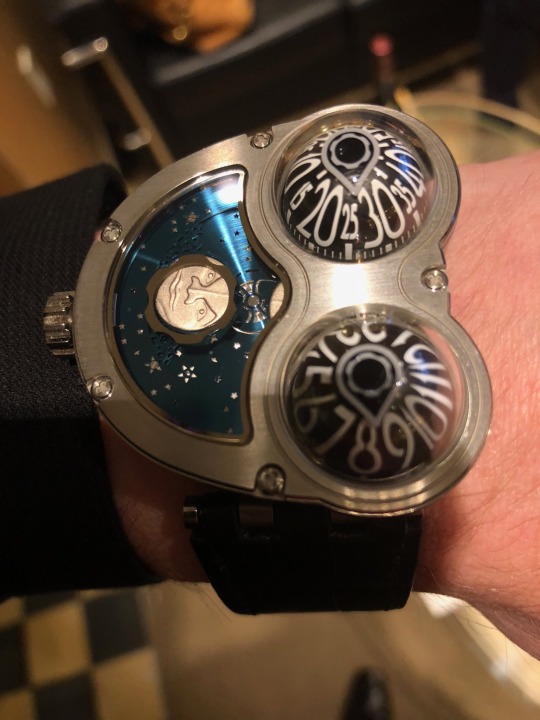
It seems rare that “regular people” run into the geeks and nerds of horology, but when they do, they seem to be quite puzzled by our passion. At the same time, those who have their own passions—or perhaps a desire to be passionate—marvel at our expressions of lust over these antiquated objects. How do you explain to a person of the world—in context with what appears to be the current global climate—how you value timepieces above all other pursuits?
I suggest that it is largely to do with what C.G. Jung called “individuation.” You can find a definition for that word and a few others that I will use here: http://www.psychceu.com/jung/sharplexicon.html. I spent enough time defining my terms in grad school, so I will only do that in this space when I feel the need to fully drive a particularly difficult point home. The long and the short of it is this: we have an innate drive to become the fullest expressions of who we truly are as individuals. Part of the way we achieve this is by connecting to the archetypal Self. The Self is represented by the mandala image, and the mandala image of the Swiss and most other watchmakers appears to be the wristwatch.
Packing a very difficult dissertation into an extremely tight nutshell, the wristwatch—for those of us who “feel the love,” as it were—is in fact our own beacon of Self. It centers us, it encapsulates us, and it allows us to find a full or complete experience of who we are as individuals. The wristwatch is at the center and the exterior of what gives our life the meaning about which Joseph Campbell spoke.
To some this might seem insane, and I would not argue with that, but sanity is merely a shared hallucination. In the realm of horological enthusiasts, our shared hallucination—one that seems to serve the complementarity of our souls—serves us in similar ways to how others find enlightenment, or at least contentment.
Some might ask, “what about clocks?” Great question. I am not speaking for the clock enthusiasts, as much as I also love clocks and other horological instruments. The wristwatch is a vastly more intimate object because it is worn. The watch rests against the skin and becomes a part of us. We count on our watches like friends who can “spark joy,” as Marie Kondo puts it. And our watches are the R2D2 companion to the X-Wing that is our mortal form.
One might ask, “so then will any watch do?” The answer to this is certainly a resounding “no,” but I will delve into that later when I’ve had a chance to write more deeply and compassionately about why certain watches aren’t worth your time. This has less to do with the value of any given watch and more to do with one’s authenticity in their selection process or adventure.
The picture above was taken by me. A very special friend allowed me to try it on and I will always be grateful to him for that priceless experience. If you don’t know what it is and why it’s so special, feel free to ask ;).
1 note
·
View note
Text
Return to Public Writing
It has been a while since I have written for a public audience. Normally I either keep my writing to myself or I share with a very limited group. However, it will be best from now on if I begin to build a record of writing accomplishments for professional purposes. This blog will expand from being just about timepieces to also being about topics that are important to me. For example: consciousness, philosophy, depth psychology, active imagination, and dream journaling. It is not important to me to gather any type or size of audience or to influence others. All I care about here—for now—is having a record of things that I think are important and also what my writing capabilities look like in a simple format. Thanks for visiting.
1 note
·
View note
Text
AN (IM)PERFECT COLLECTION
An Horological Psychologist’s Magnum Opus, or How a Lowly Graduate Student Amassed a World-Class Collection of Fine Timepieces.
By: Andrew Lawrence Smith
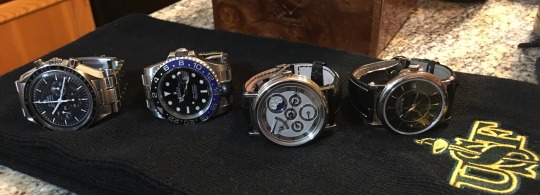
Part 1
You might think it’s easy to collect watches, but I’ll have you know that even if you’re the richest person in the world, you simply cannot know what to buy and when and where and why to buy it until you have put in an insane amount of work. In some ways it really evens the playing field between the rich and the working class because it’s not about money, it’s about achieving a holistic collection that balances and harmonizes everything from wrist-time to occasion. Collecting is as much of an art as the watches themselves. Some people get lucky, sure, but then again some people win the lottery and if you’re reading this, that is not going to happen to you, probably ;).
Hi there. My name is Andrew and I am a 37 year old PhD student and Jungian Depth Psychology Consultant finishing a dissertation in Jungian & Archetypal Studies and Horology at Pacifica Graduate Institute. Do they offer the horology part? No. I created that after being unable to separate my depth psychological research from wristwatches. This is what we deem a vocational call. When you spend hours observing the least and the greatest of watches under magnification to understand what “fine” means and when you press each watch against your ear to hear every tick and tone made by the watch, you’re just barely beginning to be on the path. My research discusses how timepieces, the wristwatch in particular, might function as a modern mandala, having a real connection to the unconscious archetypal Self, but that goes way beyond the scope of this essay. To understand some of the terms I use, you might need to dip into Jungian depth psychology, and for the most important definitions, they can be found here: http://www.psychceu.com/jung/sharplexicon.html
Many arrive at a collection that fits them by procuring countless timepieces and then throwing them back into the abyss in order to please their peers (fashion watches and status pieces) and have the experience that refines one’s taste, some of which I’ve done, but the serious collector will lie in wait like a dragon observing from atop a mountain of gold; the gold being serious knowledge, in the vein of attempting to acquire an horological and psychological philosophers’ stone. When all variables align—after months and years of reading and discussing and visiting boutiques and second-hand shops either brick-and-mortar or online—only then will one receive the full satisfaction of the perfect watch for them, the perfect complete set, and the perfect price to once again return to one’s perch fully satisfied with the catch/game of a lifetime. Needless to say I will not be discussing the auction world at all. Auctions are for rich people. Although the rich or super-rich should go through the process that I have gone through, they really don’t have to. Their loss. Then again, they hire guys like me to pick out their watches! This is a story for the ultra-conservative (no politics implied) watch collector. The metaphor of the miserly, yet punctilious dragon, represents the foundation of the composition of an horological psychologist. Horology is cool, psychology is cool, but I contend that it is only when the whole process of being an horologist is twinned with the knowledge and experience of depth psychology that one can truly enter into this deeper world of alchemical achievement, understanding, and appreciation.
Put another way, what I have found from studying wristwatches—as they relate to universal mandala symbols—is that the image of the timepiece, especially the wristwatch (in my own psyche) replaces every single religious symbol with a unified and integral symbol of the height of human consciousness and beyond. I’m more than just your average atheist, I am an horological psychologist who has integrated world mythologies into a knowledge and gnosis of being that connects the alchemically perfect timepiece and the supreme meaning of the individual and collective psyche; Jung’s notion of the archetype of the Self, the whole being of the individual. For more on that, you can hold out for my completed dissertation, and in the meantime read C.G. Jung’s “Memories Dreams Reflections.”

The image above was taken by me and is from C.G. Jung’s “The Red Book: Liber Novus.” It is one of many mandala images that Jung created to symbolize the whole Self archetype. A perfect watch on the wrist does not fall short of the feelings evoked through this depiction of presentiating origin: becoming fully integrated into the purest harmony of consciousness.
Part 2
It was by accident, or rather synchronicity, that on the 28th of June, 2012 I found myself attracted to a cheap, skeletonized mechanical wristwatch that was glaringly out of place amid items I was perusing to fill a few needs for my San Francisco apartment. I had been studying Nikola Tesla in depth and was possessed by the genius of his inventions and notions of free electricity. I thought that using/wearing a watch, which would need no battery replacement, was/is an ecologically responsible and very cool thing to do. At $120, it seemed expensive, but I was overcome by a strange feeling of passion and curiosity in the name of the great Tesla (best human who ever lived) and so I ordered it. Full disclosure, I sweat bullets on the MUNI back then thinking someone would mug me for that watch. Now I ride the bus with a Rolex hanging out like IDGAF x). But I digress.
Upon removing the watch from its box for the first time after it arrived at my door, little did I know that I would from that day forward never go another day without enjoying a mechanical watch on my wrist. Case and point, at this very moment I am wearing my Breguet 5327. Thus commenced hours upon days of winding, listening, and viewing the watch under magnification so that I could figure out how everything worked. It might’ve been a poor excuse for a watch, but I could not stop staring at all of the moving parts, which had me mesmerized as if I was flying through the clockwork at the train station in the film Hugo.


Even in this bottom-of-the-barrel movement that had been manufactured in a place with vastly lower standards than Switzerland, I could see motion and beauty that had/has me transfixed on a level that was/is far greater than any basic aesthetic, technical, or functional appeal. I purchased a few loupes—5x, 10x, and 30x—to get a closer look. Since I still have this watch, I do not have to imagine what it feels like to dive into the minute details of every stationary and moving part. I can gaze upon, and through, the synthetic rubies right now and see a universe of possibility in an instrument that is only meant to tell us where the sun in the sky might be at any given moment so that we will know when to perform certain socially agreed upon human rituals. That said, with each of my watches I often engage in Active Imagination (a Jungian method by which one re-members or discovers knowledge sourced from the collective unconscious) and the imaginal entities that animate in my own mind, inspired by the wristwatch, tell endless, fascinating stories.
Two years after encountering that initiatory watch, owning cheap mechanical watches of various designs and complications (my experience of horology exposure 101), I finally took the plunge and bought my first fine timepiece. Now to be fair, I must mention that I spent a lot of time during those years defending my cheap watches as if owning something that costs more than a few hundred dollars US would never be necessary, like some poor souls still do, but eventually I grew up and made the sacrifices necessary to possess something serious. You need a thick skin in the watch world in order to interface with other Modern Day Watch Enthusiasts who are worth talking to. Surviving your own ignorance to become horologically knowledgeable is a noble and brutal journey through the underworld. And as Jung would have it, emerging from this underworld is simply another stage of individuation; an expansion of consciousness improving the abilities and life of the individual.
My first fine watch was the Omega Speedmaster Professional ref. 3577.50 “from the Moon to Mars” purchased on the 2nd of January in 2014. Obsessed with Elon Musk’s dream to travel to and terraform Mars, as a byproduct of being equally obsessed with Nikola Tesla, this was a watch that not only met all of my horological desires but also instantly possessed a multiverse of meaning for me. I imagined that one day I would take this watch with me on a public transport to the Red Planet. Elon wants to die on Mars, and quite frankly, so do I. To me this watch was so expensive (for me at the time) and so perfect that there would never be a reason to own anything else. Again, little did I know that I would be very wrong about that. Enter the “Coke.”

The Rolex GMT-Master II 16710 Coke began to burrow into my mind as I continued to scour the internet for the best deals on fine watches of all kinds. Every single day I was on eBay, Chrono24, watchestobuy, watchuwant, Crown & Caliber, Jomashop, The RealReal… You name it, if the site was selling fine watches, I was keeping tabs. Apologies to anyone I missed. By this time I was reading magazines, blogs, and watching all sorts of videos that were giving me a fairly exhaustive exposure to what was out there and who was buying/selling certain kinds of timepieces in certain categorical brackets. My aim was/is to understand watches on a deep psychological level as they affect the experiences of others and of course my own Self. Not just to be a numbers guy who can flash the timepiecs but say almost nothing meaningful about them. I must confess that it is important to know that, in regards to my personality type (INFP), I operate heavily by listening to my own intuition, and I could not shake this watch; just as I could not shake the Mars. There was more than just the analysis and process of elimination, it was something like a powerfully religious magnetism. The Coke was coming to me in my dreams. I have the dream journal to prove it! However, that’s in my dissertation. On a number of occasions I placed offers on a Coke, but came up with nothing because either a) the seller was shady, or b) I just couldn’t get the price or set where I wanted it. Dealing with watch sellers can be tricky, unlike being face to face with your local AD, so it’s important to be patient and cautious; to not be so excited about that exact watch you’re hunting that you get taken for a ride.
Then finally the day came when I saw a great deal for a clearly authentic Coke (gotta have that paperwork) in amazing condition and I made an offer that stuck. Again, I thought I was going to be done forever. That this was the collection of a lifetime. I had unique Speedmaster that almost no one else had and I had a Coke, which is a highly respected and desired timepiece across the globe. I chose the GMT because I could use it to track 3 time zones more efficiently than on any other timepiece, including world timers, and this came in very handy with all of the traveling and international communicating that I do. Not to mention, the whole design of the watch and color scheme is unusually attractive and versatile (still my favorite Rolex, aside from material objections), but I had not ever seen one in the metal. On a flight home from Cyprus I ran into a guy who was wearing one. I asked him if I could see it and of course he obliged. I have pictures to prove it (see below). I was wearing my Moon to Mars and just knew that the Coke would complete the circle for me. The one thing that I did not really take into account until my own Coke arrived was the size, which didn't register on that agonizing flight back to the US from Cyprus, where I had attended an amazing conference on Time and the Psyche. The conference was a magical experience, but I do not recommend that anyone fly a cumulative 44 hours just to have 5 days on the ground, no matter where you are going.


I ordered my 16710 from 1989 at a great price in pristine condition with papers and when it came, I was bewildered. It seemed so small! Was it actually fake? Did I get bamboozled? Impossible. All of this time I had been looking at huge blown up pictures of the watch and assumed it had the same presence as a Submariner, but there it was, 100% authentic and smaller than I expected. I wanted that Submariner-style crown, big and chunky, but after a while the size of the 16710 crown began to make sense and the tasteful nature of this specific piece became clearer from one day to the next.
I spent so much time examining this Coke, to make sure that it I hadn’t made a mistake, that synchronistically every aspect of its charm became powerfully apparent and intoxicating beyond belief. I had been wearing obnoxiously large watches with Chinese tourbillons that dwarfed even my Speedmaster and now finally the curse was lifting. I saw the light. Praise the gods! Certain watches worked for certain wrist sizes and certain moments in life. Wearing a watch that is too big for you is simply childish and lacking in discipline and taste, just like believing that there is a god that is literally real. This Rolex functioned as training wheels for wearing watches that actually fit properly and looked correct for my physical build and personality type. I remember thinking that the bracelet was too narrow and that the case of the watch only covered the surface area of my wrist, which made it feel like there wasn’t enough watch there, but in reality it was a match made in mythological, alchemical heaven. To this day I still think that the textural design and character of that vintage Oyster bracelet is better than the new 904L iteration and that the 116710 is right on the line of just barely being not too big. Unless you’re deliberately trying to be a clown, a dinner plate on the wrist is no bueno.
In all of my idealism, I thought that the Coke and the Mars were going to be my life companions, but alas we never really do finish growing and developing. Especially when we finally meet that special someone! Enter the Kwan.
Part 3
It was my great fortune to synchronistically meet (a story for another time), date, and ultimately marry my wife, the magnificent Jane Kwan, who for better or for worse has supported me through this transformational journey that is watch collecting. She was kind enough to be fascinated at first, and is now at least tolerant, but when I began to show her how you could actually store value or even potentially make a little money with the acquisition and sale of certain timepieces, she started to pay attention. Chinese people, like those of my Jewish heritage, love a reliable investment opportunity. I made it my goal to abandon hunting “good deals” on a wide range of watches and began hunting the exact watches that I would personally want to own and wear (not just stick in a vault), but only if the price was extraordinary or unusually fair. The Internet has made this relatively easy, if you’re willing to put in the time, and so I scoured the entire visible market for what I felt would be the perfect watch. Long story short, I discovered and then began to obsess over and follow/hunt the Patek Philippe Calatrava 5153G-001. Believe me when I tell you that I have written many pages about why this watch is, to me, the perfect dress watch, if not the perfect watch all around, aside from not being as durable as a Rolex, but again I digress. To be honest, this watch was my holy grail (a subject that I have expounded upon in other places as possibly the single most abused horology term aside from “in-house”) and I thought that I would never get to see it in my lifetime.
One day I found the Calatrava for sale online at a price that was unbelievable. My wife is almost painfully patient, and so we watched the piece sit on the website for nearly a month, while I nearly fell apart with anxiety waiting for her to make a choice. In the end, her instincts were right because the price continued to go down. But I really could not comprehend why no one was buying it. When we made the phone call to see about a best offer, we were able to take the price down even lower and so acquired the watch well below value thanks to my wife’s belief and investment in me, your humble watch hunter. Blasting into the side of this mountain precipitated a landslide to follow.


Not long after that my wife wanted something that she could wear every day. I had been hunting the Rolex Datejust 116234 with black dial, because it is my favorite iteration of the DJ and was able to find that watch well below value also. I thought it might be a bit large for her, but when it arrived it was a perfect fit at 36mm. While the watch is very cool, and occasionally I’ll sneak it away from her to wear it for a little while, it doesn’t make the cut for a perfect collection for me. I needed my watch collection to devour the catalogue of essential horological functions and representations.
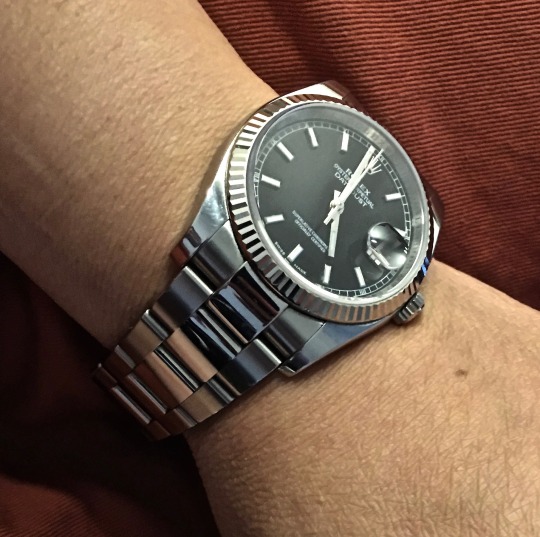
However, I was jealous of the almost white-gold looking oyster bracelet and thus I faced a dilemma. The call to adventure was back! I realized that I could own both my Mars and Coke or I could sell them and own the singular Rolex GMT-Master II 116710 BLNR as basically an even trade (at the time), a watch that I still think is slightly less appealing aesthetically than the Coke as it at that time pertained to my personality, but possesses the ultimate in materials ever released from Rolex. I needed some time to think about this. Rolex’s alchemy game had become massively stronger than where it was in 1989. A few weeks later, in Honolulu, I was flipping through one of the tour books and when I turned it over to look at the back, there it was: the BLNR. Synchronicity, as usual, was determined to prevail. Now, I know that this watch is heavily advertised, possibly more than Tag or Hublot if that’s possible, but at that moment I felt like I was looking at a picture of a long-lost friend. The time had come to pull the trigger. I had spent several lovely days swimming in the ocean with my Coke, and now it was time to let it go.

The beach I frequented during my stay in Honolulu. Anyone who has been there knows where it is ;).

A shot of my Coke in Honolulu on the way to get some Spam Musubi!
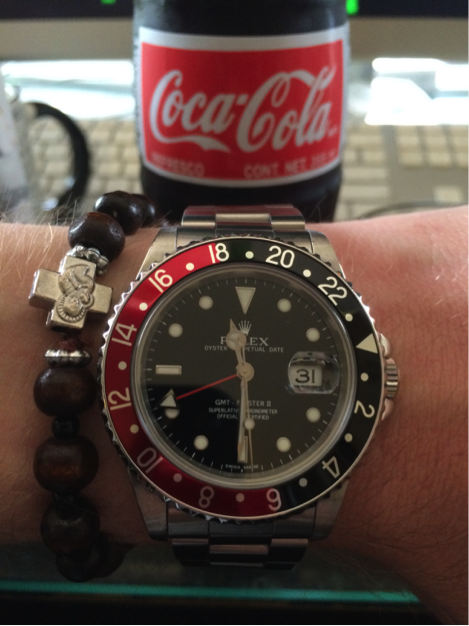
The rosary bracelt pictured here was acquired in Cyprus, gifted to me by the great Angeliki Yiassemides (author of “Time & Timelessness”), not long before I managed to acquire my Coke. The meaning is strong in this image…
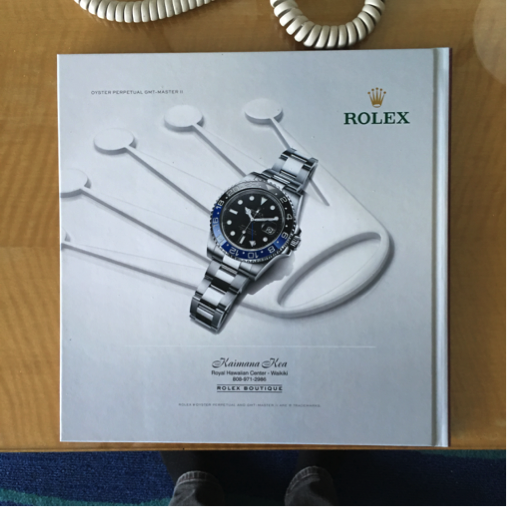
The book in the hotel room demanding that I trade up.

Horology boutiques... Always calling me…
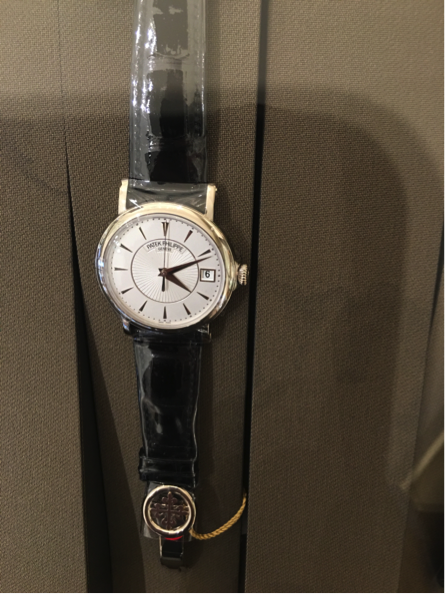
Impossible to find one with black dial in a boutique, I spent some time admiring this beauty in white before that time came when my wife made a dream become reality.
With a heavy heart, I managed to part with my first fine watch and my first Rolex, selling them for fair market prices. Finding the BLNR for a steal is basically impossible, especially if you’re looking to buy within a relatively tight timeframe (aiming to acquire the watch mere months before moving to Copenhagen), so I found the best deal I could with a complete set and as planned basically traded about the same amount of money for those two watches to buy the one BLNR. This was good enough for me and my wife because it is still holding around the same value I invested and I basically had the experience of buying a brand new Rolex with a complete set minus stepping foot inside of an Authorized Dealer, an experience that is not at all important to a watch hunter like me; at least not at this time of life, but maybe later when I have established myself and I can afford that level of treat.
I honestly thought that I wouldn’t be as happy with the BLNR, as with the Coke, because black and red is so much more “me” along with other reasons and qualities (yadda yadda yadda, as Jane is fond of saying), but when it came I was filled with excitement. I opened the box and there it was: my long-lost friend whom I had been missing for the gods know how long. Most call it the Batman, I knew immediately that this was to be my R2D2. It doesn't matter that so many others own it or that the adverts were drilling into my brain. Consolidating to this watch was possibly the best horological decision I’ve ever made because although there was still a lingering color objection, I suddenly had a monstrously better watch to wear every day that met every single other checkpoint I felt one could demand from a daily-wear: 1. 904L steel, which really does feel like wearing white gold, but not quite as heavy a. Something that can take the hits and scratches and will withstand polishing dramatically better 2. White gold hands and indices, which contrast perfectly against the black dial 3. Blindingly bright blue lume, which my wife prefers to her green lume and makes it easy to tell the time under any circumstances aside from maybe actual blindness 4. The blued Breguet overcoil hairspring in the tried and true 3186 movement, something I don't even need to see to appreciate 5. The 5mm comfort link, which is a huge design leap forward compared to the oversized and floppy comfort extension on the original Oyster bracelet 6. GMT aligned clicks, which didn’t really ever seem to line up perfectly with the 16710 7. And most important of all, the very first two-color Cerachrom bezel, completing, to me, the most wearable, useful, and legible timepiece ever made 8. When you consider that this watch not only embodies everything you’d want and nothing you don’t, it’s easy to excuse the blue and simply hope for the red to come through someday 9. Finally, in review, this watch contains the best of every Rolex white metal: 904L steel, white gold, and platinum. As such, it is an alchemical masterpiece; and it has that chunky Submariner-style Triplock crown! Now I like both crowns for different reasons.
People have been calling it the Batman, and I get that. I’m a huge Batman fan and wouldn’t try to change the moniker even if I could, but for me it is the R2D2 riding along with me as I pilot this time machine we call a human body. My consciousness is the Luke inside of this Incom T-65 X-wing Starfighter and my 116710 R2D2 is the choice navigator, always down to take a beating for the rebellion ;).

So now I had a BLNR and a Calatrava shared with my wife (plus her 116234 to enjoy when she isn’t wearing it), completing two out of four watches of a complete set that I call “a holy quaternity.” What more could a man ever hope for? Would I really ever need to break a sweat over more than these two watches to complete the ultimate collection? I even had access to my favorite Datejust when my wife wasn’t wearing it, even though it does not fit the bill for my personal living symbol of wholeness of Self. My little wrist R2D2 and our white gold Darth Vader seemed like a complete set all by themselves. And yet, there was more to come, and rightly so!
My wife and I moved to Copenhagen so that she could attend DTU to earn her MA in Architecture. Being the unreasonably lucky guy that I am, I got to tag along and spend my days exploring one of the coolest (and happiest) cities in the world whilst writing my dissertation on psychology and horology. Several months in, after spending day after day chatting with awesome folks on MDWE, a gentleman put a Speedmaster “Legendary Moon Watch” ref. 311.30.42.30.01.005 complete set in basically new condition up for sale. A discussion about how this boilerplate design was so perfect it’s boring was going around and so at first I wasn’t too keen on the watch. I remembered my Mars and thought that the original Moon Watch was too plain and too common. However, the more I looked at it the more I realized what it had to offer. So many guys were/are going in for that vintage chronograph with the running seconds and 30 minute register without the hour register, which is a great and classic and traditional watch concept/discipline, but I need the hours! Even if it challenges aesthetics and purity. Honestly, purity has never really been my thing ;). Authenticity is a whole other kettle of fish! So then what I realized was, this was not going to be a watch that I spent time looking at during the day. This was a Good Night Watch that needed/needs to be useful in the dark. What better watch for darkness and time writing/recording/chrono-scoping than a boilerplate Speedmaster?!
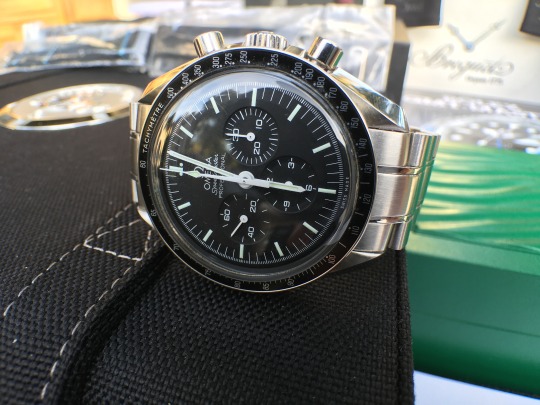
The price was fair and I could certainly get most if not all of my money back if I needed to sell it, so I figured, why not experience the moon watch as a complete package in all of its boring glory. Sure, it’s no Moon to Mars and the literature won’t come in Japanese with a dedication to one of the world’s greatest artists, Leiji Matsumoto, but it would still be qualified by NASA for space missions and there were lots of other very cool accessories that would be fun to explore. Not to mention the history, which I must say ought to be valued well above just one spectacular artist. I pulled the trigger and the watch and its enormous packaging were at my Danish door within a few days. Upon opening the display box, a feeling came over me that I did not expect. The watch was/is so much nicer than the Moon to Mars, so much more sober and less cartoonish (not really an insult, actually accurate), and it instantly felt like it belonged on my wrist and that it would blend in like some kind of chameleon-like symbiotic creature. Almost instantly I finally knew what this watch was for.
While the Speedmaster had been and is still being used for outer space missions, I would be and am using this watch for INNER space missions. I sized the bracelet, which was a joy because it came/comes with screw end-caps rather than the basic link pins, placed the watch on my wrist and then started the chronograph right before going to sleep. When I woke up in the middle of the night to journal my dreams, I knew almost exactly how long I had been asleep, which really helped me to prioritize my time so that I wouldn’t wake up so much that I wouldn’t be able to return to slumberland. After finishing my journaling, I started the chronograph again, went back to sleep, and when I woke up I could see that I had gotten the eight-ish hours I needed to be rested enough for the day. I’m sure some of you go through the process of sleeping for eight hours without even thinking about it, but my dream life is so active that it is easy for me to lose track of how long I’ve been asleep, so this watch became an instantly useful tool that I can’t live without, just like the BLNR. And because it’s manually wound, I don’t have to stress out the winding train of an automatic chronograph; plus I have the pleasure of winding a watch every morning as the third thing I do after photographing the dial and resetting the chronograph. What a sweet ritual for a watch enthusiast!
My collection was complete. Right? I had my R2D2, which would go with me everywhere during the day, and I had my Good NIght Watch, which would track my sleep intervals and follow me into my dreams. And when it came time to celebrate something special, the Darth Vader (Calatrava) would take its place on my wrist under a cuff. Who could ask for anything more? There was only one slight problem. A large part of my journey after receiving that first mechanical wristwatch was exploring RGM in depth, which led me to Breguet. While I wasn’t sold on the idea of spending big money for a tourbillon since the science shows that it essentially has no real effect on accuracy, there was an element to watchmaking that I had fallen in love with before I even considered owning a fine watch of my own: guilloché.
RGM makes a killer tourbillon (reminiscent of a Speake Marin/Hamilton hybrid), let’s not mince words, only paralleled by the likes of Breguet, Patek Philippe, and Greubel Forsey (honorable mentions, Louis Moinet and Jaeger-LeCoultre - that one’s for Tim Mosso), and does some outstanding guilloché work with their own rose machine/lathe in Lancaster, PA. However, if you’re going to really tighten the restraints on a collection that is meant to be perfect (a true holy quaternity), there’s really no other choice than to go with the godfather of the practice: Breguet; arguably the most important historical figure/alchemist in watchmaking, and the inventor of many components that even the so-called “holy trinity” (lame designation, because Christianity is for people who don’t want to read more books—funny/not funny) still benefit from today. Hence I controversially argue that Breguet completes the holy quaternity and in many ways is still on top of PP, VC, and AP as the senex manufacturer (Harlan MDWE, bless his heart, will of course agree–love you, mean it). By this time I had visited so many boutiques, Tourbillon SF being one of my favorites, that I was saturated with the knowledge of what Breguet and other top-end (not just high-end) watch companies had to offer. Out from behind the stormy clouds of tourbillons and Jacquet Droz and Blancpain and A. Lange & Sohne and De Bethune and Ulysse Nardin came a piece that on any other day I would’ve ignored.
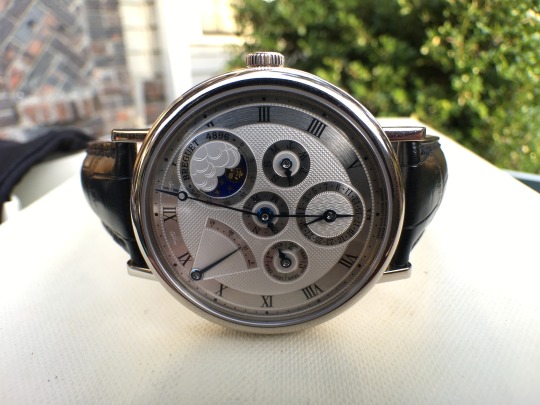
The Calatrava that was/is already in our possession does in fact have a guilloché black sunburst dial, but I wanted something that had/has/emanates the vibrant, timeless energy of 18th century watchmaking tradition, radiating from its finely crafted alchemical masterpiece of a dial and case. I had the opportunity to experience the skeletonized Breguet perpetual calendar tourbillon, but there was something missing even with that watch. Again, size and money are meaningless and relative. It was when I finally had a chance to take a close look at the 5327 that I saw that in any class for any money, this watch had/has it all. It has one of the most extraordinary complications ever invented, the perpetual calendar. It has moon phase, which is hugely important in psychology as a principle of divine consciousness. It has power reserve, which is arguably unnecessary on an automatic watch, but with the layout of the power reserve, moon phase, and date register at six o’clock, the 5327 pays perfect homage to the notorious automatic (perpétuelle) quarter-repeating watch with dumb (à toc) repeater from the late 18th century. This was/is the Breguet to own! Sitting in an office piled with books, including volumes about Breguet and the lovely publication that was created for The Legion of Honor in San Francisco, when they had their Breguet exhibition and lectures, I found myself having a full experience of awakening to the truth of yet another wristwatch. Except this time it was THE ONE. The only... This time, without a doubt, it was THE watch to end all watches, for me. I had done the work. I had read the books, scoured the Internet, been to the boutiques, met or at least studied the people, and in the end the Breguet Perpetual Calendar Classique 5327 presented itself as the answer I was looking for from both the multiverses of horology and psychology: all of the craftsmanship, all of the technology, all of the meaning, and all of the enjoyment from wearing one could ever ask for. Period, paragraph, life mission accomplished. Except, I didn't have the money x). That solution, which came later, was the real blessing.
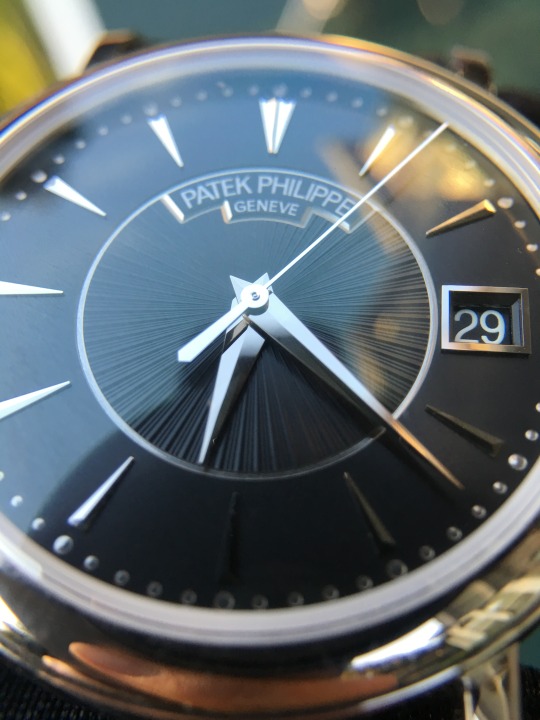
Before I get into that, on a more somber note, I would like to mention that compared to Breguet’s latest QP, the ref. 5447, Breguet made an unfortunate design decision that is not in keeping with the more traditional layout. Maybe it’s great for marketing, but it does two things: departs from the classique tradition in a way that is unbearably modern, and treads dangerously toward cheapening the name of A.L. Breguet. Swapping power reserve for retrograde month was a particularly unfortunate decision, almost as undesirable as the choice to switch the angle of the moon phase to a less interesting and, I would contend, invasive vertical position. While that dial might be slightly more efficient in terms of the flow of reference and legibility, it is far from an upgrade and has lost that original 18th century charm. I’d wager that Breguet himself might agree. As such, this specific reference, the 5327, continues to wear the crown (pun intended) as what I feel is the greatest Breguet QP wristwatch ever made. That being said, I have dubbed the watch my Holy Grail, together with the Speedmaster, the GMT, and the Calatrava, this completes my personal Holy Quaternity. However, there is always a “fifth element,” intentionally playing on a reference to the film of the same name from 1997. That fifth element (the eternal energy of love and passion) to me is the transcendent holy grail, which is a watch that is so extraordinary and so perfect for the individual that it doesn’t even exist yet. The super rich uber-collectors will know what I’m talking about: a subscription piece that perhaps one’s preferred watchmaker doesn’t even know how to make. For me, in all seriousness, this would be the currently imaginary and absurd Greubel Forsey Quantième Perpétuel Chronograph Grande Sonnerie in a 41mm platinum case. Although, I’d take a GF chronograph, as long as it’s hand-wound. Could it ever possibly get any better than that? I seriously doubt it. At least for an individual like myself.
And so recently I found this perfect Breguet at a ridiculously low price. I mean a price that normally only dealers get from other dealers. This watch needed to be procured. My wife was not about to invest another substantial sum into a wristwatch since she felt that she had already diversified in that direction far enough with the Patek. And so she suggested that I ask my father if he would be interested in making the investment. After lengthy explanations over email and handling some obvious objections that a non-horology scholar might have, he generously agreed to help me make the investment to both aid in my research and hold value that only presents itself once in a lifetime. Due to this generosity and collective cooperation, it is my privilege and responsibility to care for this Breguet as the final piece to my horological individuation puzzle. The mandalas to complete the supreme mandala of the current manifestation of my own archetypal Self have been assembled like Voltron. And now that the collection is complete, my mission is to take exhaustive photographs, engage in active imagination (alchemical hermeneutics) with each piece and the whole collection for my research, and to cook it all down in the vas alembic of consciousness to create my very own horological opus.
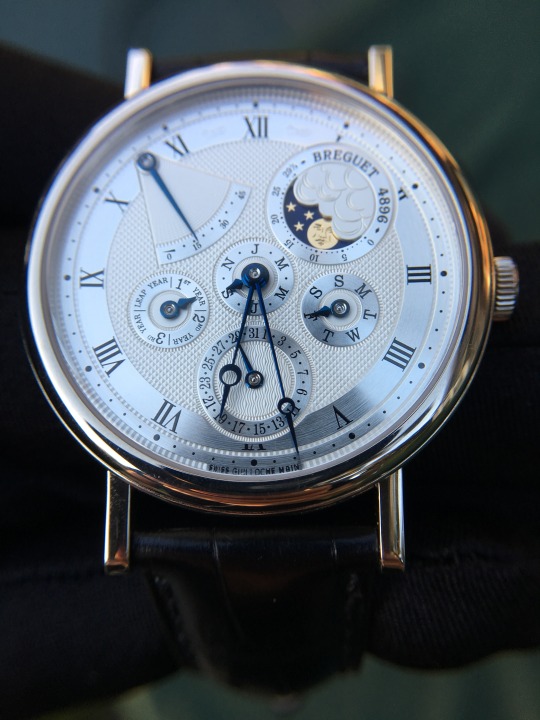
Here’s an example of what enters my imagination when I engage in reverie (Active Imagination or Alchemical Hermeneutics) around one of the watches (often including its literature), offering a lingering (reverie) around or daydreaming into the Breguet dial: The guilloché pattern for the power reserve looks like the waves of the sea or the ocean. I am reminded of the image of the solar barge in Liber Novus p. 55. Aptly placed, it is above the other complications, next to the moon phase, which is obscured by a hand carved cloud pattern: the essence of the imagination. So the heavens and the waters, forged in fire and carved into earth or metal. The pattern in the date register is that of a waterfall or descending cliffs, reaching down into the underworld. All of these being supported by the primary dial hand carved rose lathe or rose machined pyramids (clou de paris). The pyramids or sacred geometry of transcendent consciousness. Within the big mandala that is the watch dial are 5 smaller mandalas: the moon phase, which embodies our human-centric lunar story and mythology; the leap year, which makes it possible for me to see the accurate date for the rest of my life without adjusting the timepiece; the month, a centered indicator of the positions of the gods; the day, a de-centered indicator of the positions of other gods; and finally, the date, a concept invented by people who want to control time and other people, to no avail one hopes. Might be best to simply let go of that craving for control, let people be peaceful unto themselves and allow time to flow with the Force of Nature. A dream within a dream... The watch does have Breguet’s signature coin edge or fluted sides, so the watch is to be treated as a sort of super sacred coin. This coinage or coin edge appears to be symbolic of the archetypal pillar: the pillars that held Samson, the pillars of Rome, and the pillars of current modern civilization. However, even after this current human experiment is dust and rubble, the pillars of time will stand as strong as they always have and it will never have mattered that humans were a part of it. A testament from the Antikythera mechanism.
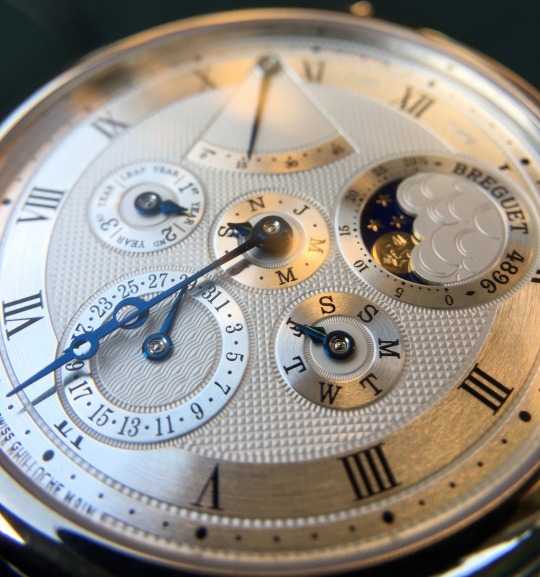
It is possible that I may actually have to sell the Breguet after I am finished with my research sometime next year, unless by some miracle I make enough money to completely own the whole thing by myself, but that is not important because all that matters is that for a time in my life I had, in my possession, a perfect collection. The Holy Quaternity! “For a few minutes, they were mine. That is enough.” https://youtu.be/c9O1VVeMzhc Charade (8/10) Movie CLIP - The Most Valuable Stamp (1963) HD.
It doesn’t matter how it got there and it doesn’t matter if I don’t get to keep it. What matters is that, since we can’t take any of this with us to the grave anyway, I have the priceless gift of the experience. This was a group effort. My sacrifices and investment were/are largely those of time, obsessive research, and unearthing opportunities, which in reality is just as valuable as the money others allowed me to use to assemble this project. From the depths of passion, love, and family, I have been made individuated and whole, for now. Through psychology and horology I have healed myself in ways most people cannot imagine and have had the great fortune to inspire others. Countering the cruel trick of the perpetual calendar complication (never being able to live long enough to see it need an adjustment), I am filled with gratitude for what I have had the privilege to do with the time I have been given. Through bringing all of these elements together, I have found true happiness and may for a time be with this imperfect, perfect collection to remind myself of the cost involved in striving to create something truly special: a genuine opus, if not magnum opus. No one can do it alone. We require relationships to individuate, as Jung said, and at the ripe age of 37, I know that my watch collection and my Self are at last in harmony.
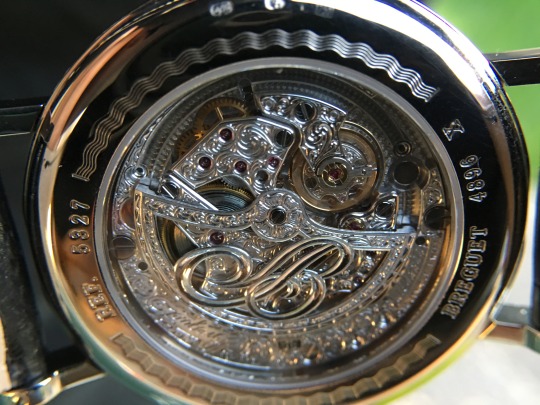
Conclusion
Watch collecting is not just some silly thing men do with their extra money, nor is it about amassing a monstrous volume of different examples for the sake of becoming your own museum. Watch collecting is as much an art as is watchmaking itself or the creation of any sculpture or painting. It requires focus, dedication, precision of craft, and most of all it requires a determination to produce the best possible result from the knowledge that has been gained and the resources—people or otherwise—that have been procured.
I am continuing to work on my dissertation on psychology and horology while figuring out where I want to focus my career from here on out. It seems like Tesla, Inc. is the most logical choice, so we’ll see if they or a watch boutique will have me. As far as this collection goes, what I know is that I will always have my R2D2 because it is the one watch that I can’t live without that can go anywhere: land, sea, air, and space. Depending on what the future holds for me career-wise, I might have to live without the Speedmaster and just use a beater chrono until I rebuild my value strength, since it takes quite a bit more to hold a collection like this all on one’s own. The Calatrava will be here because it is my wife’s investment and my privilege to enjoy as part of our partnership. However, it is worth bearing in mind that none of these things are permanent and that any amount of time being in ownership of the completed holy quaternity set is ultimately more than enough of an accomplishment no matter how long you keep it together. It takes a lot of work to learn about all of these manufacturers and iterations and value propositions. It’s even harder to get clear which ones matter to you on a profound level to the point that you would choose four and exclude all others; especially when considering that owning these watches is a choice that was made at the exclusion of any other products, such as cars, houses, hoarding currency, and any other type of man-made creation. And then to have them all just sort of casually ticking away on your desk is a luxury that very few people will ever know/experience. For that I cannot thank the people who believed/believe in me enough. I am lucky, I am grateful, I have my wife and family to thank for everything, in addition to other friends and enthusiasts who were willing to engage my passion, and I hope that what I have learned and my story will be something that is paying my fortune forward: giving back to the collective community of folks who simply wish to be their best selves; to be good citizens, as Plato might’ve imagined it.
In review and in final conclusion, this is an imperfect watch collection that to me is perfect, in my estimation from the research I’ve done and the experiences that I have had:
It is my personal gnosis, based on my research in depth psychology and horology, that there are two kinds of quaternities (not trinities, because a trinity is really just an incomplete system, lacking the feminine principle, among other things) in the horological universe: 1. The top four watchmakers in the Swiss watchmaking industry a. Breguet b. Patek Philippe c. Vacheron Constantin d. Audemars Piguet 2. The top four timepieces in an individual collection a. The Good Night Watch i. A chronograph worn to bed to time sleep intervals ii. An instrument that centers one’s being between sleeping and waking b. The R2D2 i. The most essential and sturdy of all of the timepieces ii. A trusty companion for all of life’s terrains c. The Darth Vader i. The finest example of elegant simplicity with a touch of violence ii. A watch that possesses a seemingly invisible and powerful Force d. The Holy Grail i. The watch you will wear on your deathbed that will outlast you ii. The QP is a cruel trick because it offers a feature that you will never live to enjoy: not having to adjust the watch for over 150 years. iii. A watch that satisfies one from ever wanting to buy anything better, for now ;).
Quick note: I’ve mythologized part of this collection with Star Wars metaphors because that is the best story I grew up with: the futuristic mythological vision of Joseph Campbell only barely understood by George Lucas (as is evident in his prequel trilogy), based on his seminal “The Hero with a Thousand Faces.” One could easily substitute other similar archetypes for the designations that I have commandeered. Whatever gets you there. It’s all imaginal, but inarguably objective in terms of the archetypes.
As for the selected manufacturers, my opinion here is highly controversial. Breguet should be at the top, Swatch or no Swatch, because Breguet is the Grandfather of all of these other innovators. A Breguet watch lacks nothing in quality and discovery that these other companies are engaged in and in fact, in addition to the legacy/pedigree/history of invention, Breguet is still making timepieces that exceed the expectations of any connoisseur. Every little detail is given the utmost care and contemplation. This does not, of course, take into account watchmaking in other regions. Germany, A. Lange & Sohne in particular, is making watches that appear to be exceeding even the Swiss standards of excellence. This also does not take into account even conceivably more exciting independent watchmakers and inventors like Greubel Forsey, Roger W. Smith, nor even the late George Daniels.
Final thoughts, for now:
There’s a point at which, once you’ve hunted your favorite watch for it’s best price, you stop thinking about what the watch is worth and you begin to think more in terms of what the watch is. For example, I could stand outside in shorts and a t-shirt sipping a beer while admiring a watch that retailed once for $65-70k, but what I’m really thinking about is, 1. how does it fit my wrist? 2. how long will it last? 3. when will it need service? 4. how legible is this dial really? 5. do I like the weight and the fit of the band (strap or bracelet)? 6. could this have been designed better in terms of how it handles a diverse set of lighting situations? 7. was this really the right choice for the lug length? Cheers, Marc Goldberg ;). 8. could the moon phase have been tooled to be more accurate. 9. why isn’t the power reserve exact? 10. Are there any flaws in the guilloché? I’m looking at you, FPJ! 11. Why did they design the clasp like this as opposed to the Patek clasp method? 12. And sure, this dial is amazing with all of the guilloche patterns, but I can’t really see them without magnification because a) I’m getting old and my eyesight isn’t what it used to be and b) the beauty and contrast is only apparent under certain lighting, which makes the dial look washed out at all other times; not nearly as aesthetically pleasing as the Patek, which always looks good even when its sunburst guilloché pattern disappears into the black. 13. However, the most important question of all is four-fold: a. what did/does this watch and the work mean to the watchmaker? b. what did/does this watch mean to the manufacturer? c. what did/does this watch mean to the boutique collective? d. and what does this watch mean to the consumer in every sense: aesthetically, spiritually, historically, and depth psychologically?
What’s next?
There are many watches that I still find attractive and many watches to come from the various great houses that might cause me to fall in love with one watch more than another, but to be honest I seriously doubt it. I mean, the only watch I want more than my BLNR in its category is a Coke version. The only watch I want more than my Speedmaster in its category is another Speedmaster of far rarer origin and pedigree, a vintage example maybe or who knows. As far as the Patek and Breguet are concerned, there are no better iterations of those watches and there never will be. Finally, for the ultimate grail watch, I believe that it has to be something so amazing that it doesn’t even exist yet. It has to be a dream or a fantasy that one chases and pines over until one’s heart is so broken that one cannot even leave the house without wishing it was either already on the wrist or to finally acquire the watch. As mentioned before, for me, that would be a Greubel Forsey QP chrono with moon phase and grand sonnerie; or yeah, I’ll simply take a GF chronograph, because that is what would replace the super boring yet perfect Speedmaster. Yes, the only thing that will replace the Speedmaster for me is the currently non-existent, fantasy hand-wound Greubel Forsey Chronograph. Sadly, as far as I know, it’s just not going to happen and that hurts me deeply. I want, after I’ve amassed an impossible amount of wealth near the end of my life, well beyond having had the opportunity to help others, to fund what I believe to be the greatest wristwatch ever made and while I may not be the man to do it, it is the fact that I want this for the whole of humanity and my Self that I put this energy out into the world and wish it will happen to someone someday. What you buy is a vote. When you make a purchase, it casts a ballot. I vote for fine horology all day every day. Everything else is an accessory to horology and life, even psychology and fancy electric cars, in spite of my obsession with Tesla’s inventions and values.
The argument could be made that this is not a perfect watch collection because not all complications are represented. For example, I do not have a minute repeater, much less a grande sonnerie. To that I say, I’m not dead yet. At this time of life I can still see (you know, literally, with my physical eyes) and there is this amazing thing, lume, you’ve heard of it, that makes it possible for me to tell the time in the blackest of darkness, so sure, I would love to own a chiming watch, but they’re not only way out of reach, but I don’t have any real use for them in the same way that there is value and use for the watches that I have selected (see what is of value and of use in Liber Novus). Will I ever own a QP chrono minute repeater grande sonnerie, with all of the bells and whistles like power reserve, moon phase, and sunrise sunset and equation of time someday? I certainly hope so!
P.S. Synchronistically, after finishing this essay, I went downstairs and found this puzzle to solve for my horological and mildly intellectual enjoyment :).
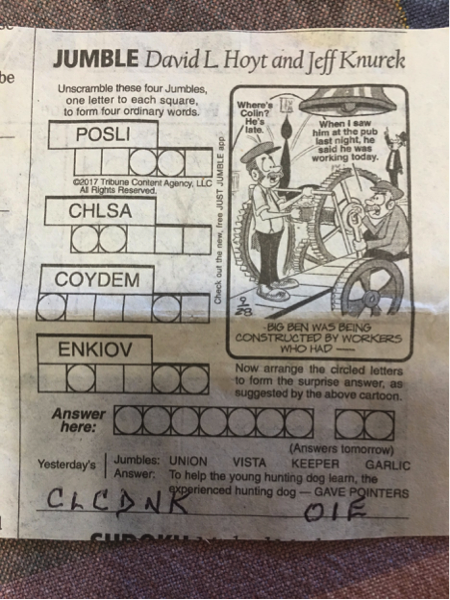
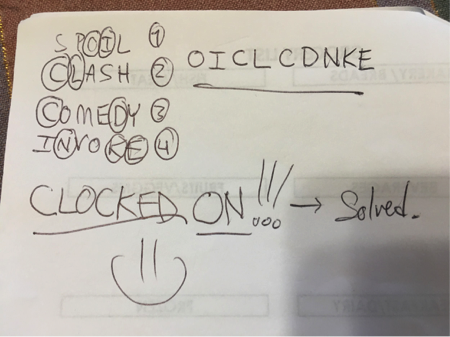
Okay, I swear this is it:
Some might ask, “so then what are your values, exactly, spending all of that time, and yours and other people's’ money, on wristwatches?” Don’t you have a job, a house, kids, a car, money, etc.? The answer is this: 1. I’m courting the job that I want to do until my heart stops: Tesla, a watch boutique, or something like that. 2. Having a house is not important to me, but maybe someday we’ll have one. Until then, my time and value will always be dedicated to horology in some way/shape/form. 3. Kids are just more people. People die. Watches are forever. 4. Cars are for suckers, unless you own a Tesla or a really sweet mechanical car, as is essentially the same case with watches. I ride a bike, and not a nice one, a cheap one, because I’d rather spend the money on timepieces. 5. I’d rather have the watch of my dreams than any amount of money. Money is just an imaginary number. The right watch is an instant and immortal best friend. a. To further make this case, look at the gentlemen at auction who are spending more more money with reckless abandon to own the perfect watch for them. Money is essentially meaningless outside of holding value to acquire goods and services. A watch is a deeply psychological and spiritual enterprise for those who really get it, and so it makes sense that one would spend it all to acquire the ultimate alchemical composition that bridges one’s “I” with the Self archetype—via an horological mandala—through the chain of watchmaker, to manufacturer, to dealer, to owner; or as Patek Philippe would have it, caretaker.
Thank you for reading.
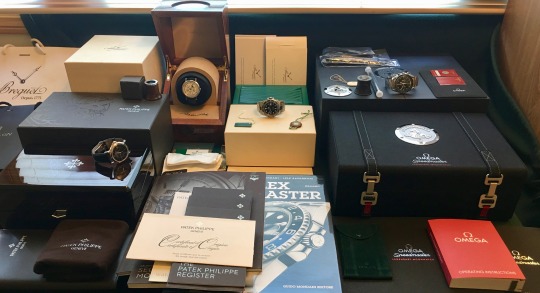
The super sacred Holy Quaternity in all of its gorgeous horolgical glory!
1 note
·
View note
Link
The Datograph Perpetual Tourbillon and the Tourbograph are probably my favorite watches out there at this point. If there was one watch to be stuck with for the rest of one’s life, it would have to be the DPT. What is your favorite watch?
1 note
·
View note
Text
Chronometers
A mechanical watch that shifts accuracy less than a second per day is kind of insanely amazing when you think about the precision and accuracy that is required to calibrate such a reliable movement. No watchmaker can insure that every watch will present that tightness of tolerance, so it remains an imperfect art. When I checked my watch today, I had not set it for at least a month. It had gained approximately 20 seconds and all hands were perfectly aligned. A mass produced ETA movement (for example) would've gained or lost well over a minute or more. That is partially why some watches cost more than others. I'm largely uninterested in precious metals (with the exception of owning one or two fine dress watches) and am totally uninterested in diamonds, which some love but I feel are a waste of money. To each their own. A chronometer that is COSC certified promises a variance of no more than between -4 and +6 seconds on a wavering scale (depending on level of regularity or precision) per day. When you have a watch that can run for 5 years or more (before service) without a battery that does not wander outside of a minute of accuracy over several months, that's what we call a "set-it-and-forget-it" timepiece. You can do the simple math to see why someone would invest in such a reliable machine as not a status symbol but an essential tool for a range of information (think annual/perpetual calendars, chronographs, and world timers, the GMT being my favorite) or just plain being on time or early. One could relate a quality watch to the cost some pay for their kitchen knives or car in comparison to people who may not use them as often as some. The personal and collective meaning discussion, as it pertains to how one becomes drawn to between 1 and 4 or more very specific and special watches, amplifies from there. I'm always interested in other peoples' opinions about this. The easy extrapolations for those who choose to participate in the world of horology are that your timepiece says something about who you are, how far you've come on your journey or vocation, and in some cases what you love to do with your time. I've heard almost every objection to the rationale(s) behind spending serious money (whatever that means to you) on a wristwatch (particularly mechanical ones that inspire the owner to take care of it) and there are so far no arguments that have ever been able to overcome what ultimately is the priceless experience of diving deeply into one's inner world with the best tool one can procure for the sake of its meaning; taking it on as a partner that enhances most experiences of life. Sure, it's not necessarily for everyone, however considering the notion that one's timepiece is like a mandala image which could be connected in some way to the Self archetype in each of us, it might be worth thinking for a moment about why you do or do not wear a watch beyond simple benefits and objections. As an aside, the most pragmatic reason to "invest" in the right watch is, it's a bookmark for the money you've worked hard to earn and it's something that has the potential to increase in value (no guarantee there) if not simply exist as a family heirloom. Can't wait to finish my dissertation on this... Final thought for now, many people have it all wrong when it comes to their thinking about who "deserves" to have one or more of these extraordinary devices. It's no big deal for the affluent because it's easily had. Those who truly understand this world of horology have gone through great pain and sacrifice to possess and experience their grail. Paul Pluto, who some love and some hate as a person and watch critic, said "it has to hurt!" And I think there's some truth in that. When included with the tension of sustaining one's mindfulness and willingness to do the work of being human (performing one's job, taking care of family, playing sports, exploration of all types, etc.), the struggle to acquire and maintain one's ultimate watch, and all that it will do with and for one, becomes an integral part of the entire dance of one's existence. At least that's what I think. We'll see what the literature has to say...
2 notes
·
View notes
Photo
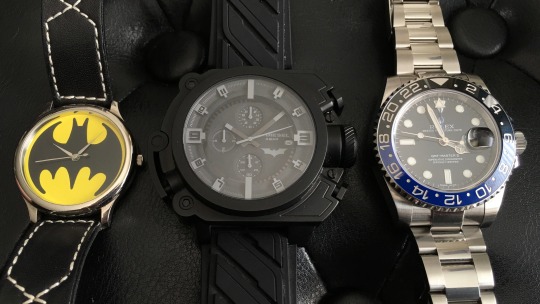
My Batman watches! 1989, 2012, and 2015. Does anybody have any other Batman watches that they like? Maybe a JLC?
#gmt gmtmaster gmtmasterII batman#goodnightwatch rolex watch watches wristwatch timepiece horology mechanical finewatches wristart
1 note
·
View note
Text
Horological Musings
Today I am sitting impatiently in anticipation of my Rolex GMT Master II 116710 BLNR arriving at my door tomorrow. It has been a long road on the way to arriving at this watch acquisition decision. As a collector who had to spend a lot of time making mistakes and self-teaching to learn about how the wide range of watches work and which ones are worth owning for the sake of value, function, and meaning, my ultimate conclusion is that the BLNR is the very best modern watch to own in any category. While I have learned a lot about vintage, those watches are more costly to maintain and so I have opted at this time in my life for a watch that holds a strong value position, still has over 3 years of Rolex factory warranty coverage, and is made of the latest and greatest materials that will allow the watch to survive the perils of daily wear.
One might say, “well yeah Andrew, the BLNR is cool and all, but why give it so much praise?” I have many answers to that, but I’ll attempt to keep it simple. The first consideration is mobility. What if I need to sell it? A watch that hovers at or below $10k appears to be the sweet-spot for moveable sales in the luxury or fine watch market. I will have an easier time moving this watch in case of emergency because of the wide net a listing of this sort casts. The best next option would be a 16710 recently serviced, which I traded toward this watch, but would ultimately end up costing me more money to maintain in the long run.
So I dodged a bullet on shelling out for service while acquiring a physically stronger timepiece that is still under warranty. The next reason this watch is the best is universal desirability. The buzz over this timepiece is huge and if the price is right it will always sell relatively quickly. You can’t do that as easily with a similarly valuable watch from another manufacturer. One might ask, “so that makes the watch generic and then why do you find it so meaningful?” All of the meaning that built up and that I’ve assigned to the “Coke” has more or less transferred over to the BLNR. I’ve written about that meaning from a depth psychological perspective elsewhere, but will most likely tackle that subject again soon.
The last thing I would like to say about this watch for now is that I will be traveling internationally and so it is a particularly secure investment in that it functions as international currency. On the negative end the watch could buy my way out of an unfortunate situation, but on the positive end being able to flash this watch out from under a cuff and blazer might provide me with the right image and talking piece for helping a boutique to sell some of their watches, if I’m fortunate enough to be hired by one.
That’s all for now. I will say some more after I have received the watch! Be well.
1 note
·
View note
Photo
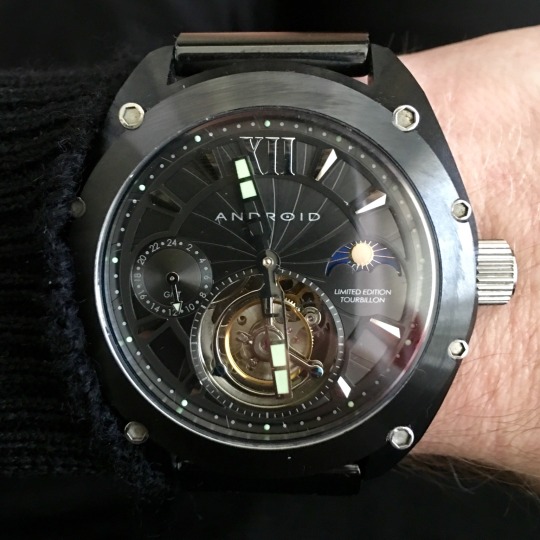
Empirical scientific research shows that the tourbillon does not increase accuracy correcting for the effects of gravity on the escapement and that the tourbillon escapement (not to be confused with complication) may cause more wear than less over time. However, it is still a wonderful invention to observe. Thanks to the Chinese for making some inexpensive tourbillon movements so that humble scholars such as myself can explore them. From the Swiss, a movement like this would cost a small fortune. All of that said, the Tourbillon boutique is still my favorite store in the world; if only to represent the continued importance of the Breguet house in horology. They may be owned by Swatch now, but that has only allowed for improvements if anything. Back to the books! at Marina Bay Yacht Harbor – View on Path.
3 notes
·
View notes
Link
Whilst I recognize that many people would strong disagree, I do think that the holy trinity composed of Patek Philippe, Vacheron Constantin, and Audemars Piguet should be a holy quaternity that includes Breguet. It seems rather irrational that Breguet would not be right at the top with that group. Since I am writing my dissertation on wristwatches and studying horological history daily, I will do my best to see this argument from both sides and show in a scholarly way, if it is warranted, that Breguet belongs in and completes what should be the holy quaternity. Trinities are for the mental stage of consciousness while quaternities are for the integral stage of consciousness, as I might employ the thinking of Jean Gebser to make my case.
#goodnightwatch breguet watch watches wristwatch timepiece horology mechanical finewatches wristart#holyquaternity quaternity
2 notes
·
View notes
Link
It’s amazing how a company can take a mass produced tourbillon movement, gussy it up a bit, and then slap it into a design-y case and sell it for over a 500%+ markup. I love the Chinese tourbillon movements because they give a man who doesn’t make too much cash the chance to experience a tourbillon, but this is taking advantage. What do you think?
#goodnightwatch memorigin watch watches wristwatch timepiece horology mechanical finewatches wristart#tourbillon starwars captainphasma
2 notes
·
View notes
Photo
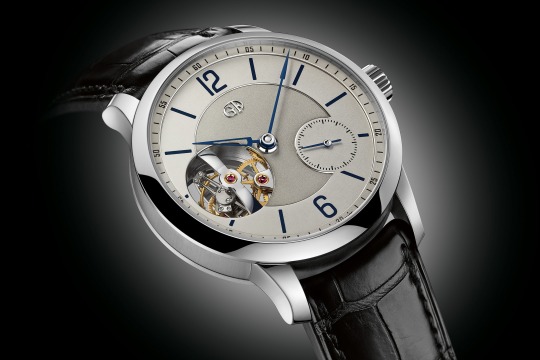
The immortal watch!! Imagine owning a timepiece that will live for all eternity...
#goodnightwatch greubelforsey watch watches wristwatch timepiece horology mechanical finewatches wristart#tourbillon 24seconds
1 note
·
View note